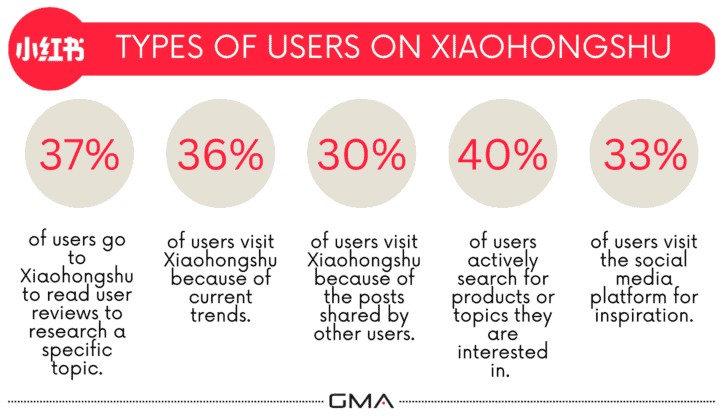
What is Little Red Book?
Little Red Book (also known as Xiaohongshu) is China’s most trusted social shopping platform. Users can share social posts, as well as shop for products. It is like a combination of Pinterest, Instagram and a short video platform.
According to the latest stats, the platform has 199 million monthly active users in China. The graphic below shows the kinds of reasons users flock to Little Red Book. As you can see, the platform is popular with users actively searching for inspiration, product reviews and information, as well as current trends.

Source: GMA
In terms of the user demographics, Little Red Book’s userbase is mainly Chinese cosmopolitans, with a strong focus on the younger generation and female audiences.
What is new with Little Red Book marketing in 2024?
1. Influencer marketing on Little Red Book
The first marketing trend for Little Red Book for 2024 that I would like to talk about is the importance of influencer marketing.
Let’s begin by answering the question: what sets Little Red Book apart from other search engines and attracts users to search on Little Red Book? The answer is that rather than providing the user with more traditionally “authoritative” sources like webpages or news websites, Little Red Book allows users to search for user-generated content to find solutions for their daily life needs.
Little Red Book holds a very important position in the Chinese consumer purchasing process and it serves as a platform for users to discover new brands, read product reviews, and find inspiration for purchases.
For brands, there are two key insights to be aware of:
Firstly, given Little Red Book’s strong emphasis on the trustworthiness of authentic user-generated content, brands should actively engage in building and nurturing their community on the platform. Foster connections, encourage discussions, and ensure that your content resonates with your audience.
Secondly, whilst Little Red Book does provide search and display advertising options, it is important to note that advertising typically only plays a supporting role for influencer marketing campaigns. The platform’s community-driven nature makes influencer collaborations the most effective marketing strategy for brands. If you do decide to run advertising campaigns alongside these, it is essential to align your advertising strategy with the user-centric and community-driven nature of Little Red Book, to maximise impact.
The screenshot below demonstrates how the clothing brand Uniqlo successfully collaborated with influencers on Little Red Book:

2. Content diversification on Little Red Book
The second trend that brands should be aware of is the increasing diversification of content on Little Red Book.
Beauty and fashion have always been popular content types on Little Red Book. Recently however, as the platform’s userbase expands, users have begun showing a more diverse range of interests, with content categories including food, hobbies, home decor and entertainment becoming more popular. In fact, the three fastest-growing content categories in terms of search volume on Little Red Book last year were electronics, education and travel.
One of the reasons contributing to the growth of these content categories is the change in user preferences after the COVID-19 pandemic, with users starting to pay more attention to their residential environments and personal experiences.
Apart from content categories, one thing that brands can also look into is how competitors are being creative in presenting their content on Little Red Book. Nowadays, you do not see brands just presenting their products by simply introducing their product features or functions. Instead, brands are thinking creatively about ways to help users relate to their products in their daily lives.
The screenshot below showcases a good example of this. It demonstrates how a high-end water heater brand strategically marketed itself to an audience seeking a refined lifestyle. In addition to partnering with a lifestyle influencer to show how the heater can complement home decor, the brand also collaborated with a parenting influencer to demonstrate how individuals can indulge in their own private spa experience at home. This approach transformed the brand from a conventional electronics brand to one that resonates with seekers of a refined lifestyle, who are the primary audience on Little Red Book.

Final thoughts and tips for marketing on Little Red Book in 2024
To summarise, my biggest tip for brands marketing on Little Red Book in 2024 is to keep an eye on the changing user demographics and the topics they are interested in. Little Red Book is trying to expand its userbase to stay competitive, so brands should explore opportunities to collaborate with different influencers and content creators in order to ride this wave. Good luck!
Need help with marketing on Little Red Book?
I hope this blog post has been a useful overview of the key tips and trends to think about when doing Little Red Book marketing in 2024.
If you would like assistance with any aspect of Little Red Book marketing, reach out to Webcertain today! Our friendly team of international social media marketing specialists will be happy to help.
Want to learn more?
This blog post is part of a series on APAC digital platforms in 2024. Check out the others below:
- WeChat marketing tips for 2024
- Line marketing tips for 2024
- Naver social media marketing tips for 2024
- Naver search advertising tips for 2024
- Baidu search advertising tips for 2024
- Yahoo Japan search advertising tips for 2024
You can also watch our webinar recording on this topic here.
Amy Chan
Latest posts by Amy Chan (see all)
- Little Red Book marketing tips for 2024 - March 15, 2024
- WeChat marketing tips for 2024 - February 19, 2024
- What’s the difference: WeChat service vs subscription accounts - January 23, 2024




